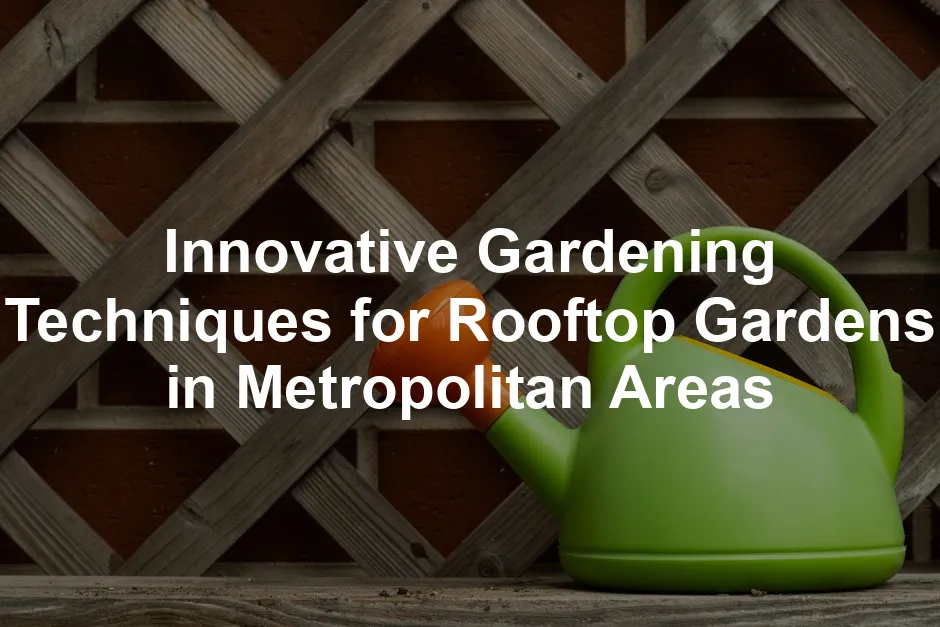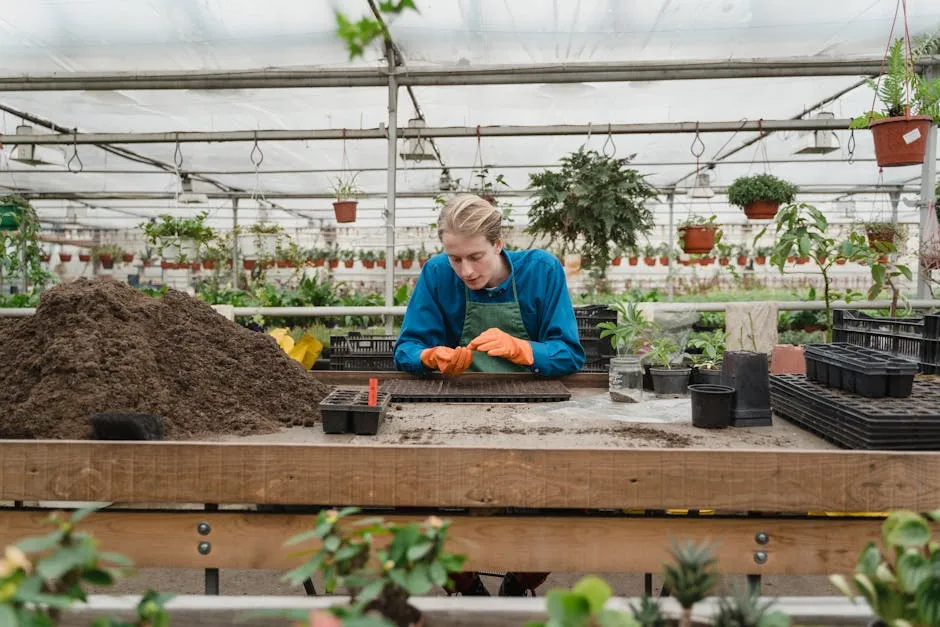

Innovative Gardening Techniques for Rooftop Gardens in Metropolitan Areas
Introduction
In a world where urbanization seems to swallow every bit of green space, rooftop gardens have emerged as a breath of fresh air—literally! Picture this: thriving plants, vibrant flowers, and fresh herbs nestled atop skyscrapers, transforming concrete jungles into lush oases. With innovative gardening techniques tailored for metropolitan areas, these rooftop gardens are not only aesthetically pleasing but also pivotal in addressing urban challenges like air pollution, heat islands, and food insecurity. Rooftop gardens offer urban dwellers a unique opportunity to reconnect with nature. They provide a fresh source of produce and enhance living environments. Imagine enjoying a salad made from your own rooftop greens, all while sipping a refreshing beverage and gazing at the skyline. Sounds dreamy, right? If you’re looking to maximize your rooftop gardening experience, consider a Vertical Garden Planter. This space-saving gem allows you to grow herbs, flowers, and even veggies without taking up precious floor space. Perfect for maximizing your urban oasis! In this article, we will explore a variety of innovative gardening techniques that can help you cultivate a fruitful rooftop garden, regardless of the challenges posed by city living. Urban gardening has never been more exciting or accessible! Whether you’re a seasoned gardener or a curious newbie, these techniques will inspire you. Get ready to take your gardening to new heights—literally! With a little creativity and determination, you can turn that unused rooftop space into a thriving green paradise. So, let’s dig into the world of rooftop gardening and discover how to make the most of these elevated spaces!
Summary Section
Rooftop gardens offer a unique opportunity for urban dwellers to reconnect with nature, grow their own food, and enhance their living environment. This article will explore several innovative techniques that make rooftop gardening viable and enjoyable, including vertical gardening, hydroponics, and the use of lightweight soil systems. We’ll begin by discussing the challenges urban gardeners face, such as limited space, wind exposure, and water management. Urban environments can be tricky for plant growth. However, with smart strategies, these hurdles can be overcome! Container gardening, for instance, allows for mobility and versatility in plant selection. Plus, selecting resilient plant varieties that thrive in urban conditions is essential.Furthermore, the article will examine sustainable practices such as composting and rainwater harvesting. These help create a self-sufficient rooftop ecosystem. Composting not only reduces waste but also enriches your soil. To kickstart your composting journey, consider a Compost Bin for Kitchen Scraps. It’s a simple way to turn kitchen waste into nutrient-rich compost for your plants! Rainwater harvesting ensures your plants stay hydrated without increasing your water bill! By using a Rainwater Collection Barrel, you can collect and store rainwater for irrigation, making your rooftop garden even more sustainable. We’ll conclude by emphasizing the social and environmental benefits of rooftop gardens. Improved air quality, reduced energy costs, and enhanced community engagement are just a few perks. Picture neighbors bonding over a shared love for gardening, creating a sense of community in the sky! Curious about how to turn your rooftop into a green paradise? Let’s jump into the innovative gardening techniques that can help you transform your urban space into a thriving garden oasis!For more on maximizing limited space in urban gardening, check out this guide on how to implement permaculture principles in urban gardening.

Challenges of Rooftop Gardening
Rooftop gardening in metropolitan areas presents a unique set of challenges. First, let’s talk about limited space. Urban environments often offer scarce square footage. Balconies and rooftops can feel like precious commodities. To maximize this space, consider using vertical gardening techniques. Install trellises or wall-mounted planters to take advantage of upward growing potential. These methods allow for more plants without sacrificing valuable floor space. Additionally, opting for lightweight containers helps manage weight on rooftops while maintaining aesthetic appeal.Next, we have wind exposure. On rooftops, wind can be relentless. It can dry out plants faster than you can say “basil pesto.” Strong gusts can damage fragile leaves and cause stress to your greens. To combat this, consider installing windbreaks. Tall plants or decorative screens can act as natural barriers. Choose sturdy plants that can withstand the wind, like ornamental grasses or hardy perennials. This way, your rooftop garden remains a thriving green space, not a wind-swept desert. Lastly, there’s the challenge of water management. Watering systems can be tricky on elevated surfaces. Rooftop gardens often have limited access to water sources. A reliable irrigation system is crucial for keeping your plants hydrated. A Drip Irrigation Kit is an excellent option. It delivers water directly to the roots, minimizing evaporation and water waste. Rainwater harvesting is another sustainable method. Collecting rainwater can provide a natural source for your plants during dry spells. By addressing these challenges, you can create a flourishing rooftop garden that stands tall against the odds of urban living.For inspiration on vertical gardening, explore these DIY vertical gardening ideas for apartments.

Container Gardening
Container gardening is a game changer for rooftop spaces. It offers flexibility, enabling urban gardeners to maximize limited areas. You can use various containers, from classic terra-cotta pots to stylish wooden boxes. Each type has its perks. Terra-cotta is porous, allowing for excellent drainage, while wooden containers provide insulation for roots. For a modern twist, consider upcycled materials like old buckets or repurposed crates. It’s eco-friendly and adds character!When it comes to soil, lightweight mixes are a gardener’s best friend. Regular garden soil can be too heavy for roofs, risking structural integrity. Look for lightweight potting mixes designed for containers. These often include ingredients like perlite or coconut coir, ensuring proper aeration and drainage. And speaking of drainage, always ensure your containers have holes. Nobody wants a soggy plant! Now, let’s talk plants. Opt for varieties that thrive in containers. Herbs are perfect; they don’t need much space and are always handy for cooking. Basil, cilantro, and mint can elevate any dish. If you’re craving veggies, try cherry tomatoes or dwarf peppers. For flowers, consider marigolds or petunias. They add a splash of color and attract beneficial insects. Remember, container gardening is all about experimenting, so don’t hesitate to mix and match!For more container gardening ideas, see this article on container gardening ideas for small spaces.

Sustainable Practices
Sustainable practices are crucial for thriving rooftop gardens. Composting kitchen scraps is an excellent way to recycle waste while enriching your soil. Start small! Use a container to mix scraps like vegetable peels, coffee grounds, and dried leaves. Just avoid meat and dairy. In a few weeks, you’ll have nutrient-rich compost that makes your plants sing with joy.Rainwater harvesting is another sustainable gem. Collecting rainwater is easy and reduces your water bill. Utilize barrels or buckets to capture rainfall from your roof. Attach a simple gutter system to direct water into your collection containers. This water is perfect for irrigation. Just remember to check for mosquito larvae—no one wants a mini swamp! You can easily set up this system with a Rainwater Collection Barrel. Lastly, think about planting native species. Native plants are adapted to local climates, making them easier to care for. They also attract pollinators like bees and butterflies. Creating a pollinator garden supports biodiversity and helps maintain healthy ecosystems in urban areas. Plus, who doesn’t love a buzzing garden full of life?For tips on composting in small spaces, check out this Guide to composting in small backyard spaces.

The Benefits of Rooftop Gardens
Rooftop gardens are more than just pretty spaces; they have significant environmental impacts. They improve air quality by filtering pollutants and absorbing carbon dioxide. This is essential in urban areas, where air quality often suffers. Additionally, these green spaces can reduce the urban heat island effect, making cities cooler. Studies show that having plants on rooftops can lower surrounding temperatures significantly. But it doesn’t stop there! Rooftop gardens foster community engagement. They provide a space for neighbors to connect over gardening. This shared experience can build friendships and strengthen community bonds. Imagine gathering for a potluck featuring homegrown veggies! These gardens create a sense of belonging and collective responsibility towards the environment. To make those gatherings even more enjoyable, consider using Outdoor Garden Furniture Set for those cozy evenings. From an economic perspective, rooftop gardens can increase property values. Properties with green spaces often attract higher rents or sale prices. They also help reduce energy costs by providing natural insulation. Less reliance on air conditioning in summer and heating in winter translates into savings. Thus, rooftop gardens are a win-win for your wallet and the planet.
Conclusion
Rooftop gardens represent an innovative solution to the challenges posed by urban living. They provide opportunities for sustainability, community connection, and food production. Imagine stepping onto your rooftop and being greeted by a flourishing garden. It’s a delightful escape from the concrete jungle below. These green spaces not only beautify our surroundings but also contribute to a healthier environment and community. Embracing techniques like vertical gardening, hydroponics, and sustainable practices, anyone can cultivate a vibrant oasis above the hustle and bustle of city life. Vertical gardens save space while allowing plants to thrive. Hydroponics enables soil-less growth, perfect for rooftops. For those interested in hydroponics, a quality Hydroponic Growing System can provide a great setup for growing fresh produce without soil. Sustainable practices, such as composting and rainwater harvesting, create a self-sufficient ecosystem. Rooftop gardens can also play a crucial role in mitigating urban issues. They help combat air pollution, reduce heat islands, and provide fresh produce. The social benefits are plentiful too! Neighbors can bond over shared gardening experiences, turning rooftops into community hubs. So, whether you have a small balcony or a spacious rooftop, taking the plunge into urban gardening is worthwhile. Your green oasis awaits! With a bit of creativity and determination, your rooftop can become a thriving sanctuary. Let’s make our cities greener, one rooftop at a time.
FAQs
What plants are best for rooftop gardens?
Choosing the right plants is vital for rooftop success. Opt for hardy varieties like herbs, vegetables, and flowers that thrive in containers. Consider plants like cherry tomatoes, basil, and marigolds. They are resilient and add beauty and flavor to your garden.
How do I manage water on a rooftop garden?
Water management is crucial for rooftop gardens. Drip irrigation systems work wonders, delivering water directly to roots while minimizing waste. Rainwater harvesting is another smart solution, collecting water for irrigation during dry spells.
What are the legal considerations for rooftop gardening in cities?
Before starting, check local regulations regarding rooftop gardens. Some areas may require permits, especially for structural modifications. Building codes often dictate safety requirements, so ensure your garden complies with these regulations.
Can I grow vegetables year-round on a rooftop?
Yes! With the right setup, you can grow vegetables year-round. Consider using greenhouses or cold frames to extend the growing season. Hydroponics also allows for year-round cultivation, regardless of weather conditions.
How do I start a community rooftop garden?
Starting a community rooftop garden begins with gathering interested neighbors. Find a suitable rooftop space and obtain necessary permits. Organize planning meetings to discuss plant selection, gardening practices, and maintenance schedules. Collaboration is key to success!
Innovative Techniques for Rooftop Gardening
When it comes to rooftop gardening, creativity is key! Urban spaces may be limited, but innovative techniques can help maximize your green potential. Let’s explore some of these ingenious methods, turning your concrete rooftop into a blooming paradise.
Vertical Gardening
Vertical gardening is a fantastic way to save space while adding lush greenery. This technique allows you to grow plants upwards instead of outwards. Think of it as a green wall! Install trellises, wall-mounted planters, or even hanging pots. These structures not only look stunning but also free up floor space for other plants or activities. Consider a Trellis for Climbing Plants to maximize your vertical space! Consider climbing plants like beans or peas, which are not just decorative but also productive. Herbs like rosemary and thyme also thrive in vertical setups, providing fresh flavors for your kitchen. The best part? Vertical gardens can be a real conversation starter, turning heads and sparking curiosity among your neighbors.
Hydroponics and Aquaponics
Hydroponics and aquaponics are soil-less gardening methods that are perfect for rooftop spaces. Hydroponics involves growing plants in nutrient-rich water, allowing for faster growth and higher yields. You won’t even need a hefty soil supply!Aquaponics takes it a step further, combining plants and fish in a symbiotic environment. Fish waste provides nutrients for the plants, while the plants filter the water for the fish. This method is sustainable and efficient, providing fresh fish and veggies from your rooftop. Imagine hosting a dinner party featuring a salad topped with your very own homegrown fish! Sounds like a dream, right?For more information on aquaponics systems for small-scale food production, check out this article on aquaponics systems for small-scale food production.

Container Gardening
Container gardening is versatile and incredibly easy to implement! You can use a variety of containers, from traditional pots to creative upcycled materials like old buckets or wooden crates. The options are endless! Lightweight soil mixes are essential for rooftop gardening. Regular soil can be too heavy, risking structural integrity. Look for potting mixes designed specifically for containers. These mixes often include lightweight materials like perlite or coconut coir, ensuring your plants thrive without weighing down your roof. Container gardening also allows you to customize your plant selection. Consider growing a mix of herbs, vegetables, and flowers that thrive in confined spaces. Dwarf varieties of tomatoes, peppers, and even strawberries can flourish in containers. Plus, they add vibrant colors to your rooftop oasis! For a delightful selection, check out an Organic Herb Seed Collection to get started on your culinary adventure!
Sustainable Practices
Sustainability is at the heart of rooftop gardening. Composting is a fantastic practice to reduce waste while enriching your soil. Set up a small compost bin for kitchen scraps—just avoid meat and dairy. In a few weeks, you’ll have nutrient-rich compost ready to feed your plants! You can also use Organic Fertilizer for Containers to give your plants that extra boost! Rainwater harvesting is another sustainable technique. Collect rainwater from your roof using barrels or troughs. This method not only conserves water but also provides a natural source for irrigation. Your plants will appreciate the extra care, and you’ll feel good about reducing your water bill! Consider planting native species as well. Native plants are adapted to local climates, making them easier to care for. They attract pollinators like bees and butterflies, fostering biodiversity and supporting local ecosystems. This not only beautifies your garden but also contributes to a healthier urban environment.

All images from Pexels



